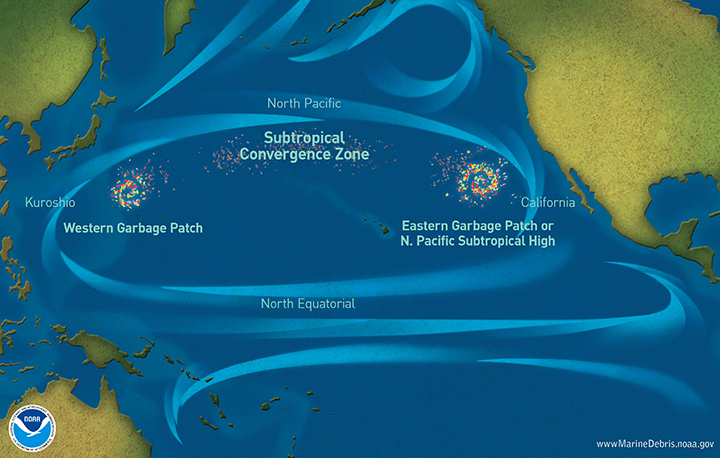The phrase conjures up images of compacted pallets of ready-made sandwich containers, straws, and to-go coffee cups. Grand expanses of solid human produced waste that bobs on the surface of the water. Plastic creating new land mass. For over 40 years, since the first discovery of the “plastic islands” scientists have spelt doom and gloom for the future of the world’s oceans if plastic consumption continues to increase and the existing plastic in our world is not properly dealt with. Unfortunately for us the problem is harsher than even those doomsday scientists let on.
The world’s plastic islands aren’t solid masses of pseudo-land that can hold human habitation like the squashed garbage hills of San Francisco. The smallest of these islands cuts through the South Pacific Ocean culminating in 1 million square acres of plastic polluted water. Size reference, that’s about 1.5 times the size of the state of Texas. In reality these “islands” are swirling columns of plastic refuse that

swims in the currents of the ocean. Following what are called ocean gyres, or circles that form as currents glide past each other. These gyres are constantly fluctuating, as such it’s possible to go right through a known plastic island and never see the evidence. Every ocean has gyres and each of the world’s five major oceans has a garbage patch as a result.
This phenomenon, however, is what makes plastic islands more dangerous for our environment than the common idea of a floating landfill. While there are plenty of large or medium sized pieces of plastic, the islands would be more accurately described as ebbing collections of micro-plastic, which would resemble schools of fish on a microscopic level. Once the micro-plastic is in our water systems it’s rotating its way through the entire water cycle, meaning that if the fishes are swimming in it humans are drinking trace amounts of it. Micro-plastic is created in the same way small pebbles are made from big rocks. A large piece of plastic breaks into fragments and over time these small fragments become microscopic. Unlike rock dust, micro-plastic won’t degrade and even at a microscopic level poisons its surroundings.

While that may sound less dangerous than larger, chunky plastic pieces invading the oceans and water ways; here’s the problem: birds still swallow and die from these plastic pieces, fish can still inhale them and get their gills torn, but mostly we can’t clean them up. Were the issue a true plastic island conservation attempts would be a large net run through the water scooping up the pollutants. Micro-plastic is there to stay and making its way into the water cycle. The only way to start cleaning up the mess is to cut off the source of the pollution.
Rule number one of living environmentally friendly is usually to drive less, the idea being that we burn less gasoline and therefore cause less air pollution. Plastics are made from the same material that gasoline is derived from: petroleum oil. More oil is used and extracted from the earth for use in plastic production than for gasoline. More than half of this plastic is intended for single use purposes before being thrown away. Single use plastic includes items like plastic straws, disposable cups, plastic water bottles, food packaging, cling wrap, protein powder containers, make-up containers, basically any piece of plastic that most people come into contact with in their daily lives. Of this plastic about 15-40% of it is not properly recycled and ends up in the oceans.
A great way to be more environmental is to consume less plastic. Opt for glass, aluminum, paper, iron, hemp instead; all these having a shorter biodegrading time if not recycled and all easier to recycle or re-purpose than plastics. This rule goes for people who try to be more earth friendly in their eating habits as well, a lot of vegetarian or vegan food comes in excessive amounts of packaging. Some people try to re-purpose their plastic containers in attempts to be more environmentally friendly, while valiant is not recommended. Unless the container specifically states it’s intended for multiple uses, the plastic it is made of will begin to leech chemicals into the contents. Affecting multiple systems in the human body.
Humans are trying in increasing amounts to live eco-friendly and care for the other creatures that inhabit the world alongside us. Plastic with its constant, seemingly benign presence can be easily over looked. Most of us don’t even think about it now, with how much it’s used. The ebbing currents of plastic running in our oceans however would beg another glance at a reusable water bottle instead of the single use one so easy to pay for at a gas station.
